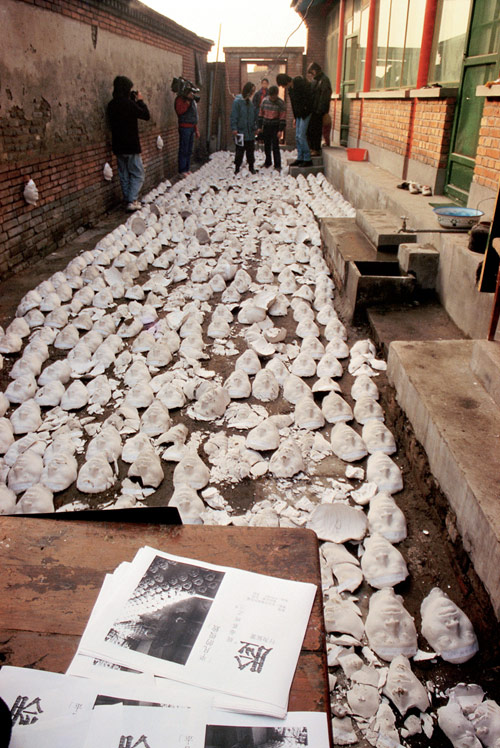
踩脸
早在1994年,艺术家苍鑫就直接将自己脸部的原型翻制了多达1500多个石膏面具。取名为“病毒系列—平凡的极致”的这件作品,呈现方式:复数般地铺列在北京他租借的房屋小院的地面上,同时请观者鱼贯地进入到这样的场景中,并以随意地踩碎这些他自己的石膏面具的互动行为过程来完成。当时,在美术圈内通俗地称之为“踩脸”。鲁迅对悲剧下的定义是:将人生有价值的东西毁灭了给人看,似乎苍鑫有意无意地延续或转化了鲁迅的这一概念,不同的是他自己的“脸”由观者“毁灭”给人看。以“我的脸”作为观念的媒介,一方面,通过“我”的自身破碎,抵达对自身生存境遇质疑和消解这一现代主题的表达;另一方面,通过“我”这个明显带有主体意识的创作者、表述者,在沉默、凝重、忍耐与负重之中,感受到一种对苦难的迎纳、对大地的皈依、对生命中最本质色泽的掬洗与抚慰。值得注意的是,他在每一件面具的背面都记录了翻制的确切时间,仿佛是从现实性的时空中寻找历史性的记忆,以一种时间的对位法来测度现实在自己面部的痕迹与变化,并由此表明自己对这种变化的态度。
没有一种方式能够完全为回顾者重现过去的生活。一张脸,一个表情,很难代表一个时代,可关于一个时代的任何一部洋洋洒洒的巨著,也未必能穷尽一幅面容的意味,尤其是像苍鑫这样从自己的面部翻制下来的石膏原模。因为这张面具存在状态的真实性和不加修饰的直接性,往往会在文字语言的尽头才更加生动和亲和。经过一定距离下的审视,以及亲自的触及、踩碎善于隐身的历史痕迹和生存记忆,才会有意想不到的视觉上和心理上的显现。
从某种角度上说,苍鑫的这件早期作品是他和同代人遭遇的时代强行赋予个人的共同生存经验和记忆,也是他及他同代人的为乌托邦的幻想与现实断裂的重构,并以“毁灭性”以戏剧化结构状态的设置与观者互动性的场景,作了一次“清算”、消解和做新的价值判断。与其说这是回忆过往的经验,还不如说是反讽过往的记忆,这经验和记忆是个人的,同时也是时代的。以反讽的语言方式质疑了现实生存的景象,以荒谬的展示方式凸现了存在的本质。这使得这件作品既虚泛又灵动,既荒诞不经又直指生存本相,既凌乱无序又布局严谨。也许我们的视觉面对,不可能获得情感层面的轻松和愉悦,但是,当观者沉浸于这一看似荒谬的场景和行为过程的内部,沉浸于每一次类似于诡辩的对话之中,我们又可以非常鲜活地感受到某种人性的乖张,生存的悖谬,以及面具表情流露出来的创作主体的怀疑姿态、批判立场,隐喻着“存在便是一种荒诞”的思想背景。
失落的幻想与断裂的现实是我们生存状态所必须面对的精神困感和人文选择。苍鑫的1500多个在不同时间翻制的自我面具,以及“粗鄙”踩脸的行为过程及结局,在一定程度上就是对我们现实文化情景的诠释。从这个意义上讲,他超越了对生存与毁灭这一现代主题的开掘,已达到了相当的思想体恤、追问与救赎的人文关怀的终极目标。
Lost IIIusions and Fractured Realities
—On Cang Xin Trampling Faces
Feng Boyi
Back In 1994 Cang Xin made a mould of his own face and used this to cast more than 1500 plaster masks. This work entitled Virus Series Highest State of the Mundane was exhibited in the following way: the multiple pieces were laid out like paving stones in the small yard of the artist’s rented room in Beijing, then the audience members were invited to enter the scene one by one. The work was completed through an interactive performance process whereby the plaster masks were arbitrarily trampled on and crushed beneath the audience’s feet. This work was popularly known in art circles as Trampling Faces.
Lu Xun defined tragedy as destroying the things that are of value in human life in order to show them to people. It seems that intentionally or unintentionally Cang Xin was extending or transforming Lu Xun’s idea: he showed his own‘face’to people by letting it be‘destroyed’by the audience. Here ‘my face’is used as a conceptual medium. In one respect, through the self-destruction of ‘I’the work expresses a questioning of our own existence and an exorcism of the modern age. In another respect, through the ‘I’of a creator or narrator clearly possessing subjective awareness, amid silence, dignity, patience and responsibility we can feel an acceptance of suffering, an Initiation of the earth, a cleansing and soothing of life’s most essential colours and lustre. It is worth noting that on the back of each mask the artist recorded the exact time of its casting, as if searching for enduring memories in the reality of here and now, using a temporal counterpoint to measure the traces and changes of reality in his own face, and also making clear his attitude towards these changes.
There is no way in which someone who is looking back on life can completely recapture the past. A face or an expression cannot adequately represent an era, neither are the great epics and masterpieces of any age necessarily able to exhaust the meanings of one human face, Just as Cang Xin’s manufacture of plaster masks was unable to exhaust the mould of his own face. Because these masks exist in a truthful state of unadorned directness, their vitality and affinity can only be felt beyond the borders of written and spoken language. After examining them from a certain distance and then personally touching them, trampling on them, vestiges of history and memories of life, so adept at hiding themselves, will achieve a sudden visual and psychological manifestation.
Considering it from a certain angle, this early work of Cang Xin forces Individual experiences and memories of communal life into the age that he and his contemporaries find themselves inhabiting. It is also a restructuring of the Utopian illusions and breaks in reality that he shares with his contemporaries, using a “destructive”theatrical structure to create a site for Interaction with the audience. He is ettling accounts and making new value Judgements, not so much recalling past experiences assatlrlslng memories of the past. These experiences and memories are simultaneously Individual, belonging to the artist, and collective, belonging to an era. His satirical linguistic approach questions the picture Of real life, while the absurd exhibition method highlights the essential nature of existence.
This work is empty and nonspecific but also spiritually moving; it is absurd, but also directly mirrors the true face of life; it is both chaotic confusion and precise composition. This work is unlikely to provide emotional